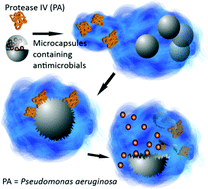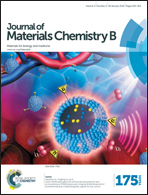Bacteria-triggered degradation of nanofilm shells for release of antimicrobial agents†
Abstract
Due to an increase in lifestyle diseases in the developed world, the number of chronic wounds is increasing at a fast pace. Chronic wound infections are common and systemic antibiotics are usually used as a treatment. In this paper we describe an approach to encapsulate antimicrobial agents in hollow microcapsules covered with a nanofilm shell that degrades through the action of a virulence factor from Pseudomonas aeruginosa. The shell was assembled using the layer-by-layer (LbL) technique with poly-L-lysine and hyaluronic acid. The microcapsules were loaded with a model substrate or a drug. By crosslinking the components in the nanofilm, the film remained intact when exposed to human wound proteases. However, the film was degraded and the drug exposed when in contact with Pseudomonas aeruginosa's Lys-X specific protease IV. The antimicrobial efficacy of the drug-loaded microcapsules was confirmed by exposure to virulent Pseudomonas aeruginosa. The current study contributes to the establishment of a release platform for targeted treatment of topical infections with the aim of minimizing both overexposure to drugs and development of bacterial resistance.


 Please wait while we load your content...
Please wait while we load your content...